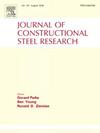Numerical and experimental reassessment of Eurocode 3 design rules for cellular beam end-posts
IF 4
2区 工程技术
Q1 CONSTRUCTION & BUILDING TECHNOLOGY
引用次数: 0
Abstract
This paper investigates the end-post behaviour of cellular beams focusing on the failure mechanisms subject to shear adjacent to the connections. Three cellular beams were tested to failure in a companion paper and their behaviours were modelled and validated herein using Abaqus. The cellular beams were connected to the columns through a bolted end-plate at one end and a bolted fin-plate at the other end. Finite element (FE) analyses were carried out for end-posts with and without notches, and web openings with half infill plates for cases where the minimum end-post width requirements were not satisfied. It was found that the FE results were in good agreement with the test results while both gave significantly higher failure loads than the design predictions provided by BS EN 1993-1-13. A parametric study was carried out on each connection side and in total 160 end-post models were examined. It was concluded that the connection type not only affected the end-post shear resistance but also influenced the failure mode. It was shown that using a half infill plate at the first opening can greatly increase the end-post's shear resistance.
欧洲规范3蜂窝梁端柱设计规则的数值与实验再评价
本文研究了蜂窝梁的端柱行为,重点研究了连接附近受剪切作用的破坏机制。在另一篇论文中对三个蜂窝梁进行了失效测试,并使用Abaqus对其行为进行了建模和验证。蜂窝梁通过一端的螺栓端板和另一端的螺栓翅片连接到柱上。有限元(FE)分析进行了端柱有和没有缺口,并与半填充板的腹板开口的情况下,最低端柱宽度的要求没有得到满足。结果发现,有限元结果与试验结果很好地吻合,而两者给出的破坏载荷都明显高于BS EN 1993-1-13提供的设计预测。对每个连接侧进行了参数化研究,共检查了160个端柱模型。结果表明,连接方式不仅影响端柱抗剪能力,而且影响破坏模式。结果表明,在第一开口处采用半填充板可以大大提高端柱的抗剪能力。
本文章由计算机程序翻译,如有差异,请以英文原文为准。
求助全文
约1分钟内获得全文
求助全文
来源期刊

Journal of Constructional Steel Research
工程技术-工程:土木
CiteScore
7.90
自引率
19.50%
发文量
550
审稿时长
46 days
期刊介绍:
The Journal of Constructional Steel Research provides an international forum for the presentation and discussion of the latest developments in structural steel research and their applications. It is aimed not only at researchers but also at those likely to be most affected by research results, i.e. designers and fabricators. Original papers of a high standard dealing with all aspects of steel research including theoretical and experimental research on elements, assemblages, connection and material properties are considered for publication.
 求助内容:
求助内容: 应助结果提醒方式:
应助结果提醒方式:


